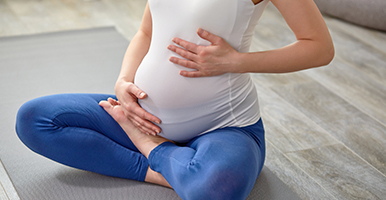Physical activity during pregnancy

It is now widely recognised that physical activity has many health benefits for both the pregnant woman and her unborn child, and may reduce the risk of some complications through pregnancy and giving birth.
Pregnant women may be concerned that physical activity during pregnancy is dangerous. There is however no evidence that physical activity during pregnancy causes harm to the baby or birth complications such as miscarriage, stillbirth, preterm delivery, or low birth weight (Davenport et al., 2018).
As health and early years practitioners, it is therefore important to encourage and support women to participate in physical activity before, during and after pregnancy.
In this section, we will cover:
- health benefits of physical activity during pregnancy
- recommended physical activity and sedentary behaviour guidelines during pregnancy
- safety considerations for physical activity during pregnancy
Important note – women with pre-existing medical conditions or pregnancy-specific health conditionsWomen with pre-existing medical conditions or pregnancy-specific health complications may need to be cautious about participation in physical activity. Before starting or continuing with physical activity, it is important women with health conditions seek advice from a relevant health professional (e.g., obstetrician, specialist midwife/nurse). Click here for more detailed guidance. |
Health benefits of physical activity during pregnancy
Recent evidence reviews conducted in the UK, Australia, Canada, and USA have identified that being physically active during pregnancy has benefits for both fetal development and for pregnant women themselves.
Benefits for fetal development
- Increased likelihood of full-term delivery (increased gestational age)
- Reduced risk of large for gestational age babies (see section on optimal birth weight)
- Reduced risk of complications during delivery (e.g., caesarean section)
- May stimulate healthy growth and neurodevelopment
Benefits for women during pregnancy
- Helps to control pregnancy weight gain
- Helps to reduce high blood pressure problems
- Helps to prevent gestational diabetes
- Improved cardiorespiratory fitness
- Improved sleep
- Improved mood and energy levels
- Better mental health, including lower risk of depression
- Less back and pelvic girdle pain
- Lower risk of urinary incontinence
- Better preparation for labour and recovery
Physical activity guidelines for pregnant women
In 2019, the Chief Medical Officers from the four home countries produced the first guidelines on the amount of physical activity recommended for health benefits for pregnant women (read the full guidelines document).
The UK guidelines recommend that for health benefits, pregnant women should engage in two forms of physical activity each week:
-
Aerobic activity - Pregnant women are encouraged to aim for at least 150 minutes of moderate intensity aerobic physical activity each week. This might include activities such as brisk walking, cycling, swimming, low impact exercise classes, yoga, pilates, and dancing.
Moderate intensity activities raise the heart rate and breathing may become heavier, but it should still be possible to talk.
A good gauge to ensure pregnant women don’t push themselves too hard during physical activity is the “talk test”. If they can still talk, this suggests they are not exercising beyond “moderate intensity”. If talking becomes difficult however, it is time to slow down, go easier, or reduce the intensity.
-
Muscle strengthening activities - Pregnant women are encouraged to carry out muscle strengthening activities at least twice a week, such as light weights, bodyweight exercises or light resistance bands. The Australian physical activity guidelines for pregnant women also encourage pelvic floor exercises to help reduce the risk of urinary incontinence.
Pregnant women are encouraged to listen to their body and adapt their physical activity during their pregnancy (see safety considerations section below).
Taking pre-pregnancy physical activity levels into account
The Chief Medical Officers’ (2019) recommendations suggest specific amounts of physical activity for pregnant women to aim towards. This level of activity may not however be achievable for everyone, especially those who were inactive prior to pregnancy. When advising pregnant women it is therefore important to take their pre-pregnancy physical activity levels into account.
Pregnant women who are already active – encourage women to continue with their physical activity, aiming for 150 minutes moderate intensity physical activity and two muscle strengthening sessions a week (as outlined above).
Pregnant women who are not active – encourage women who are new to physical activity to start slowly and gradually progress to meeting these guidelines. For example, a pregnant woman who was previously inactive could be encouraged to start with as little as 10 minutes of physical activity a day, before building up to 15 minutes, and then 20 minutes, and so on. It is important to remember that doing any physical activity is better than none.
Sedentary behaviour
As well as staying active, pregnant women are encouraged to reduce the amount of time they spend sitting. Long periods of sitting can offset the benefits of being physically active.
To help pregnant women reduce their sitting, you could encourage them to:
- Be aware of the amount of time they spend sitting, and try and reduce this by alternating with light activities that require them to move around (e.g., if in back to back meetings, could they have one of these meetings as a “walking meeting”?)
- Break up long periods of sitting or standing still (e.g., if at a computer working all day, try and move regularly to get a drink or go for a short walk)
Safety considerations for physical activity during pregnancy - key points for all pregnant women
- Listen to their body - Pregnant women should be encouraged to listen to their body and adapt their physical activity/exercise through their pregnancy. They may need to slow down as their pregnancy progresses. For example, in later pregnancy and the third trimester, outdoor cycling may be modified to stationary cycling, and activities done in a lying down position (supine) such as yoga or pilates can be switched to lying on the side. For resistance training, the amount of weights being lifted should reduce through the pregnancy.
- Don’t bump the bump - It is advisable for pregnant women to avoid physical activities that involve physical contact, collision, or risk of falling. Such activities might include kickboxing, football, netball, gymnastics, horseback riding, or skiing. Women are also encouraged to avoid activities that include leaping, bouncing, or a sudden change of direction. After the first trimester, sports where there is a risk of being hit in the abdomen by equipment should also be avoided (e.g., tennis, squash).
- Tell instructors - If women are taking part in exercise classes or non-contact sports, it is important to tell their instructor that they are pregnant.
Is it ok to run during pregnancy?For women who are used to running regularly, it is safe for them to continue to run during pregnancy (and there may be benefits for them and the baby if they do so). They may however wish to lower the intensity or reduce the distance they are running in accordance with what feels comfortable (particularly in later pregnancy). |
Additional safety precautions
Evidence-based guidelines from Canada (Mottola et al., 2018) and Australia (Brown et al., 2020) have outlined some safety precautions for physical activity during pregnancy. These are summarised in box 1 below.
|
Box 1. Safety precautions for physical activity during pregnancy (Mottola et al., 2018; Brown et al., 2020)
|
|
Warning signs to stop physical activity If pregnant women experience any of the following symptoms, they should stop the activity immediately and consult a relevant health professional (e.g., obstetrician, specialist midwife/nurse) before resuming their physical activity programme.
|
Physical activity in pregnant women with pre-existing health conditions or pregnancy-specific complications
It is important that participation in physical activity is safe during pregnancy. Evidence from a systematic review and publications using expert opinion have highlighted important considerations around physical activity in pregnant women with certain pre-existing health conditions or pregnancy-specific complications (see Mottola et al., 2018; Meah et al., 2020).
Whilst the lists below provide some guidance , it is important all pregnant woman with pre-existing health conditions or pregnancy-specific concerns consult their doctor or obstetrician for more specific advice related to their condition.
If a pregnant woman has any of the following conditions, she is advised not to take part in strenuous physical activity/exercise. She may however continue with light physical activities as part of daily living:
- Ruptured membranes (water breaking early), premature labour (signs of labour before 37 weeks gestation)
- Vaginal bleeding during the second or third trimester
- Placenta problems
- Severe pre-eclampsia
- Severe anaemia
- Cervical problems
- Evidence of intrauterine growth restriction
- Expecting triplets or higher
- Poorly controlled type I diabetes, hypertension or thyroid disease
- Severe cardiovascular disease (e.g., severe acquired or congenital heart disease, cardiac arrhythmia)
- Severe respiratory diseases (e.g., COPD, cystic fibrosis, restrictive lung disease)
- Systemic disorders (diseases that affect a number of organs and tissues)
If a pregnant women has a history of, or develops, any of the following conditions she should discuss the benefits and disadvantages of starting/continuing physical activity with a relevant health professional (e.g., obstetrician, specialist midwife/nurse):
- Gestational hypertension
- A history of spontaneous miscarriage, preterm birth or fetal growth restriction
- Mild/moderate cardiovascular disease
- Mild/moderate respiratory disease
- Symptomatic anaemia
- Well controlled type 1 diabetes
- Twin pregnancy after the 28th week
- Living with malnutrition, significantly underweight or eating disorder
- Heavy smoking (>20 cigarettes per day) with other comorbidities
- Other significant medical conditions
Key messages:
- Physical activity during pregnancy has many health benefits for both the woman and her unborn child, and may reduce the risk of some complications through pregnancy and childbirth.
- Most pregnant women can be encouraged and supported to achieve at least 150 minutes of moderate intensity aerobic physical activity each week and undertake muscle strengthening activities twice per week.
- Pregnant women should be encouraged to reduce time spent sitting, and try to break up long periods of sitting or standing still as much as they can.
- It is important to check whether pregnant women have any pre-existing health conditions or pregnancy-specific complications, and to modify physical activity recommendations accordingly. Such women should consult with a relevant health professional (e.g., obstetrician, specialist midwife/nurse) for advice before starting/continuing physical activity.
- Pregnant women should be informed of the necessary safety precautions to participate in physical activity and the signs and symptoms that indicate they should stop participation and seek further advice.



